A childhood memory that is still vivid of the Kanyakumari Bhagavathi Amman Temple in Kanyakumari, Tamil Nadu, India is of being mesmerized by the stone idol of the Goddess inside the sanctum sanctorum. In the semi-dark sanctum, a ray of light fell on the face of the deity, and suddenly the nose ring that adorned her shone brilliantly, illuminating her face.
The eyes of the deity shone with a divine lustre in the light reflected by the diamond-studded nose ring, and tears rolled down our faces, tears of pure bliss. Such is the effect of Devi Kanyakumari, at the Bhagavathy Amman Temple, Kanyakumari.
One can only imagine the effect that the Kanyakumari Temple and the Goddess Kanya Kumari (Virgin Goddess), must have had on the great Swami Vivekananda in the year 1892, when he visited and meditated at the temple, before swimming to the rock, now known as Vivekananda Rock Memorial.
Join us as we immerse ourselves in the History of Kumari Amman Temple, legends of the Shri Bhagavathi Amman Temple, and other important information to help you plan a visit to the famous Kumari Amman Temple.
Table of Contents
Kanyakumari Bhagavathi Amman Temple – Kanyakumari Mandir | Kumari Amman Temple
The Kanyakumari Bhagavathi Amman temple is an ancient temple located on the southernmost tip of mainland India in Kanyakumari, Tamil Nadu, India. It is one of the Shaktpeetha in India where a form of Parvati is worshipped. According to legend, after the death of Sati, Lord Shiva’s wife, he roamed the universe carrying her dead body.
Her body parts are believed to have fallen at different places, and wherever they fell, a Shakti Peeth, for the worship of the divine mother emanated. Some believe that there are 51 Shaktipeeths, while another school of thought believe that there are 108 Shakti Peetham.
According to legend, the Sarvani Shaktipeeth Shri Kanya Kumari Bhagavathy Amman Temple is located at the spot where the right shoulder and the area around the spine of Sati fell. The sacred and ancient temple in Kanyakumari is known by various names like Kumari Amman Temple, Devi Kanyakumari Amman Temple, Devi Kanya Kumari, and Bhagavathi Amman – Kanyakumari, etc.
Kanyakumari Bhagavathi Amman Temple History
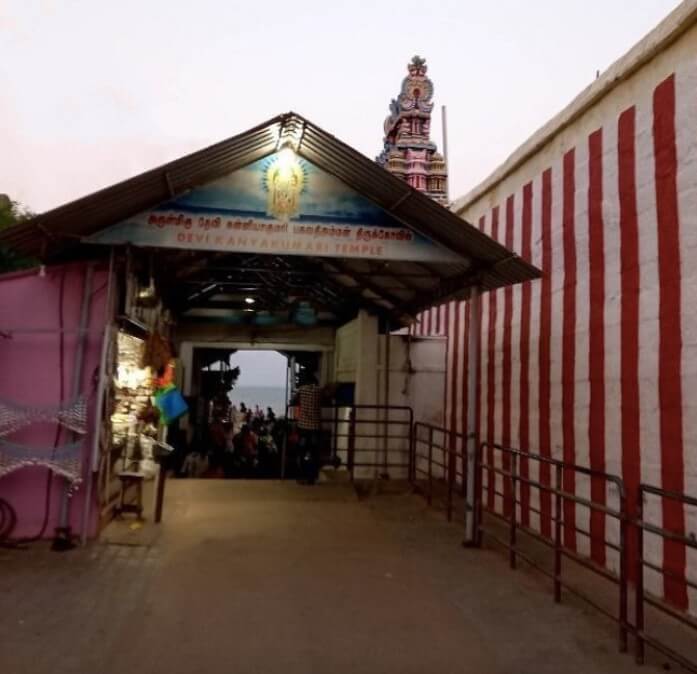
The history Of the famous Kanya Kumari Amman Temple is traced back to the mythological times. Devi Kanya Kumari finds mention in the great Indian epics, Ramayana and the Mahabharata, and also the Narayana Upanishad of the Taittiriya Aranyaka of the Yajur Veda.
Reference to Kanyakumari is also found in ancient Sangam literature. There is a reference to Cape Comorin (Present Day Kanyakumari), in the famous 1st-century work, Periplus Of The Erythrean Sea.
The anonymous author of, ” Periplus Of The Erythrean Sea,” mentions the worship of the Kanyakumari Temple Goddess, an incarnation of Goddess Parvati thus, “There is another place called Comori and a harbour, hither come those men who wish to consecrate themselves for the rest of their lives, and bath and dwell in celibacy and women also do the same; for it is told that a goddess once dwelt here and bathed.”
The mythological connection of the Bhagavathy Amman Temple in Kanyakumari India is also with Lord Parashurama, the sixth incarnation of Lord Vishnu. According to legend, the Kumari Amman Temple, Kanyakumari, is the first Shakthi Temple built By Lord Parasurama. It is also believed that Parashurama consecrated the deity of the temple, near the confluence of the Indian Ocean, the Arabian Sea and the Bay Of Bengal.
Another mythical connection of Kanya Kumari is with the lost land known as Kumari Kandam, which is alluded to in Sangam literature. This is a mythical continent, that some believe existed and is lost to the sea.
The foundations for the current structure of the temple are believed to have been laid during the time of the Pandya Dynasty. and the temple was expanded and embellished during the Nayak dynasty. Both the Pandyas and the Nayaks ruled the region from their capital in Madurai.
Kanya Kumari is believed to have been ruled by the Chera dynasty during the Sangam period and later came under the Travancore rulers. After independence, it was part of the Travancore state, and in 1956, based on the linguistic reorganization of states, Kanyakumari became part of Tamil Nadu state.
Legend Of Kumari Amman (Kanyakumari) Temple | Kanyakumari Devi Story
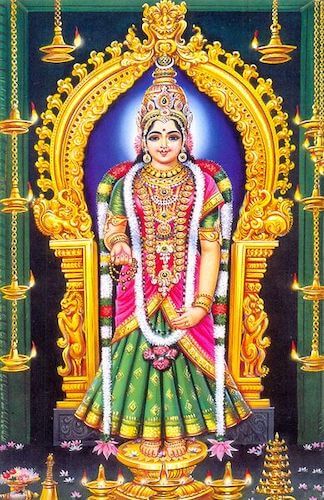
The mythological origins of the Kumari Amman Temple Kanyakumari are related to a demon or Asura king named Banasura. This Asura was the eldest son of King Mahabali, who in spite of being an Asura was a just and generous king.
In Kerala and parts of Tamil Nadu, the festival of Onam is celebrated in honour of King Mahabali who is also known as Bali and was humbled by the Vamana avatar of Lord Vishnu. Incidentally, the largest earthen dam in India located in Wayanad, Kerala, is named Banasura Sagar Dam.
Legend has it that Banasura was a staunch devotee of Lord Shiva and used to worship him in the form of a Rasalingam (Shiv Ling made of solidified Mercury) that he had received from Vishwakarma. He pleased Lord Shiva by playing the musical instrument Mridangam with his thousand arms as an accompaniment to Shiva’s Tandava dance.
He asked for Shiva’s protection as a boon which the ever-merciful Shiva readily agreed to. Banasura became arrogant and ruthless and ruled his kingdom with tyranny. He had a daughter named Usha who fell in a love with a handsome youth whom she had seen in her dream. The handsome youth was Anirudh, the grandson of Lord Krishna.
Usha’s friend Chitralekha used the magical powers she had and kidnapped Anirudh from Dwarka and brought him to Usha. The evil Banasura came to know of this and took Anirudh captive. This led to a battle between the forces of Krishna and Banasura. Lord Shiva who had promised his protection to Banasura stood like a wall against Krishna’s forces.
However, the war between the two took a crucial turn when Krishna put Lord Shiva to sleep using the Jurumnastra, with the latter’s knowledge. After this, he proceeded to sever the 1000 arms of Banasura and incapacitate him. At this stage, a truce was agreed upon and Krishna has his grandson Anirudh married to Banasura’s daughter Usha.
However, that was not the end of Banasura’s evil ways. He prayed to Brahma and got a boon that he could not be killed by anyone, other than an adolescent, unmarried girl or Kanya Kumari. This boon made Banasura even more arrogant and he thought that now he was invincible. He spread terror in all three worlds.
Even the Devas were not spared, in fact, the king of Gods, Indra was made to relinquish his throne as Banasura captured the Devaloka. There was utter chaos in the universe. At this juncture, Bhagvati, another form of Parvati, Adi Parashakti, manifested herself as Kumari in the southern tip of India.
She was extremely devoted to Shiva, who also liked her and wanted to marry her. He started from Suchindram to her place in Kanyakumari for the marriage to take place during the Brahma Muhurta.
The celestial sage Narada realized that if the marriage took place, the destruction of Banasura for which Bhagvati had manifested, would not take place. So he engineered circumstances that conveyed that it was already morning and the Brahma Muhurta was over. He succeeded, as Lord Shiva and his retinue went back without the marriage taking place.
Meanwhile, Bhagavati felt insulted by what she thought was a deliberate act of disrespect and rejection by Shiva. She flew into a rage, breaking her bangles, and destroying everything in sight. She slowly calmed down and sat down in deep meditation. Banasura who saw her was smitten by her beauty, and unaware of her real identity, tried to lure her.
Bhagavati was furious and annihilated Banasura, thus ridding the universe of the evil Asura. She had completed the mission for which she had taken her current form. She then returned to Kailash assuming her original form of Parvati to her Lord Shiva. However, she continued to maintain her divine presence as Devi Kumari in the Kanyakumari Bhagavathi Amman Temple.
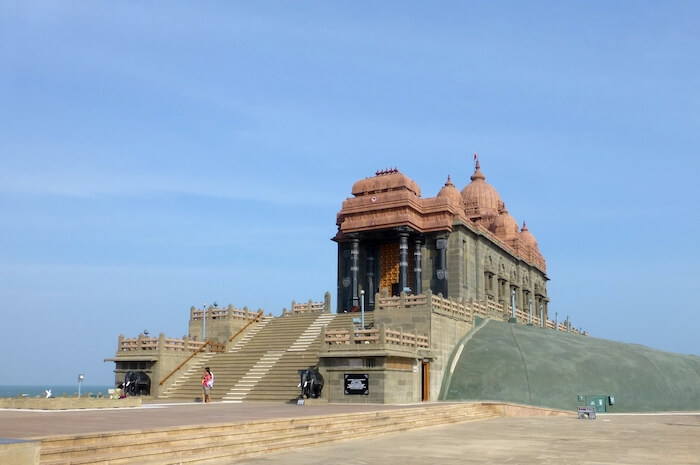
According to legend, Devi Kanyakumari meditated on a rock in the middle of the sea. According to ancient puranic texts, the rock has been known as Shripada Parai, which translates as rock blessed by the feet of the Goddess. The present-day Vivekananda Rock Memorial is located on the same rock that is revered as Sripada Parai.
Kanyakumari Goddess – Kanyakumari Devi Nose Ring Story
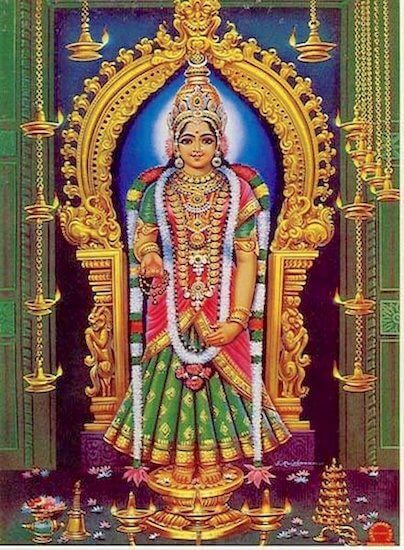
The temple is famous as the Devi Temple with a Diamond nose ring. What is the story of the diamond nose ring? What is the mystery of the Nosering? It is a very fascinating story that is sure to appeal to everyone. Visitors to the Kanyakumari Mandir, are usually mesmerized by the nose ring that adorns the deity in the sanctum. The nose ring which has a diamond glitters with a divine luminescence that is bewitching.
It may be noted that in ancient times the idol of Devi Kumari was visible from the ocean. The light reflected from her diamond nose ring could be seen far out in the deep sea. Once it so happened that the Captain of a British ship that was sailing in the vicinity was attracted by the glittering glow that emanated from the land that lay far away.
The captain steered the ship towards the light, mistaking the temple for a lighthouse. When they landed, they found the grand temple and entered through the eastern gate, which was open. Their sole objective was to plunder the temple. They were stunned by the sight of dazzling nosering, and took it away with them as their booty, with the intention of presenting it as a gift to Queen Victoria.
In the deep sea, the nosering miraculously started gaining weight and became so heavy that the ship capsized and sunk in the ocean. Everyone on board was drowned. Local fishermen later salvaged the miraculous nosering and returned it to its rightful place in the temple.
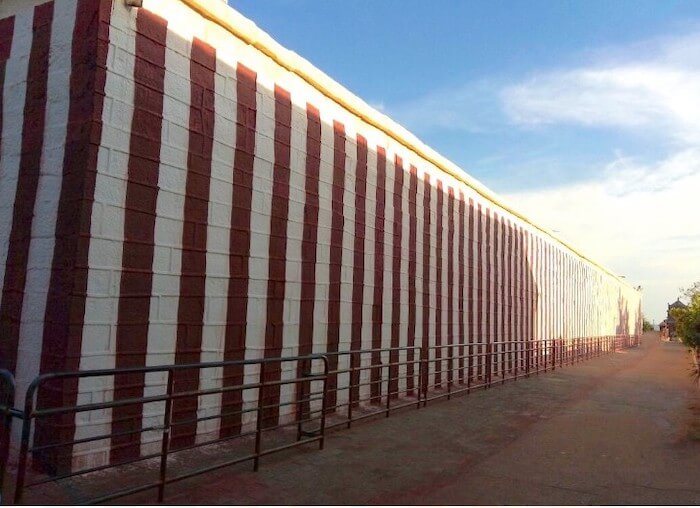
The Goddess had her nosering back. It is believed that after this incident the height of the temple walls was increased so that the light reflected from the nosering was no longer visible from the sea. The eastern door was also closed and even today it remains closed and is opened only on certain special days that are considered auspicious.
Architecture Of Kumari Amman Temple | Inside The Kanyakumari Mandir
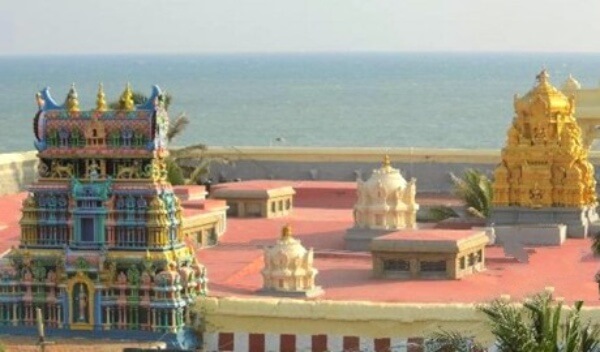
The Architecture of Kanyakumari Temple is a synthesis of elements of traditional Dravidian and Kerala temple architectural styles. There are similarities in architectural design with that of the famous Padmanabhaswamy temple in Thiruvananthapuram.
The entrance to the temple is through the northern gate which is topped by a small gopuram or temple tower. The main entrance of the Temple though is the eastern gate, which remains closed on all days, except for certain auspicious days. The sanctum sanctorum is bounded by an exterior corridor and an interior corridor. A path leads from the entrance to the outer corridor, and after you walk around it, you enter the second corridor that surrounds the sanctum sanctorum.
Near the entrance to the second corridor is located a temple dedicated to Lord Shiva who is worshipped here in the form of Kala Bhairava, a ferocious manifestation of Shiva.
Between the exterior and interior corridors are also located the Dhwaja Sthambha or the Flag pole of the temple and an ancient well that is called, “Patal Ganga Teertha“. The water from this well is used for the Abhishekam of the deity and is considered holy. The deity inside the sanctum is visible from the entrance to the inner corridor. The temple is ornamented with beautiful carvings that adorn the walls as well as the temple pillars.
An outstanding feature of the Devi Kanyakumari temple architecture is the Four-Pillared hall. The hall consists of four musical pillars and the sounds of musical instruments can be produced from these pillars. The sounds of Veena, Flute, Mridangam, and Jaltarang emanate from these pillars. These pillars are reminiscent of the musical pillars that one finds in the Vijaya Vittala temple in Hampi, Karnataka.
Inside the sanctum sanctorum stands the beautiful image of Kumari Amman, the Devi is worshipped as an incarnation of Parvati, and Bhadrakali. The Goddess is in a standing position and holds a Japamala in her right hand. The idol is sculpted in black stone. Visitors to the temple are transfixed by the serene expression on the face of the deity. The beautiful eyes seem lifelike and are filled with love and compassion.
The dazzling nosering lights up her face in a heavenly glow in the dimly lit sanctum, where only oil lamps burn. A lion motif in the pedestal on which the deity stands indicates that the Goddess is Adi Parashakti, herself.
The deity is worshipped by invoking her as Balambika or Child form of Ambika, she is also worshipped as Katyayani – Goddess of Power who is one of the 9 manifestations of Durga, known as Navadurga.
Gayatri of the Devi Kanyakumari is Om Katyayanaya Vidmahe Kanyakumari Dhimahi Tanno Durgih Prachodayat
Swami Vivekanananda And The Devi Kanyakumari Temple
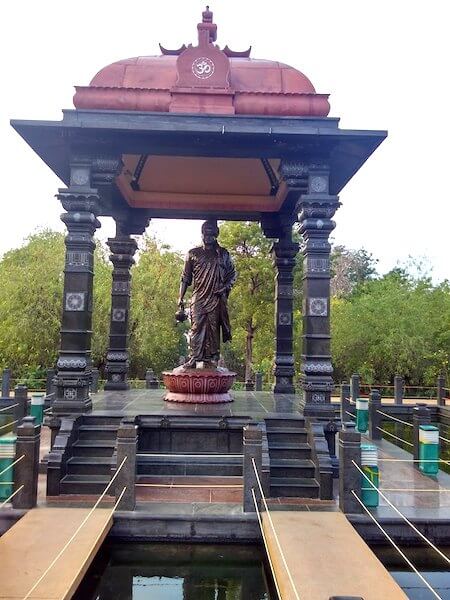
Swami Vivekananda revived Hinduism and restored the glory of Sanatan Dharma in the 19th century, much like what Adi Shankaracharya did, thousands of years before him. Just like Adi Shankaracharya who traversed the length and breadth of India, Vivekananda too travelled across India.
He travelled widely across Uttarakhand visiting Rishikesh, Almora, Haridwar and many other places. He visited Jaipur, Alwar, and other places in Rajasthan. In Gujarat, he visited Ahmedabad, Limbdi, and Wadhwan, before proceeding to Maharashtra and Goa. Later he travelled to Bangalore in the erstwhile princely state of Mysore.
From Bangalore, Swami Vivekananda proceeded further southwards. After visiting Thrissur, Kochi, Thiruvananthapuram, and Nagercoil, Swami Vivekananda reached Kanyakumari on foot on Christmas Eve, 24th December 1892.
One can only imagine the intensity of the time, that Swami Vivekananda spent in Kanyakumari. He spent some time meditating before the idol of the Goddess at the Kanyakumari Bhagavathi Amman Temple. After that, he emerged from his meditation and stood near the edge of the ocean, looking at the two rocks that he could see near the horizon.
He enquired from the locals whether there was a boat that could take him to the rock. a few boatmen were willing to take him there for a price, however, legend has it that at that time the Swami did not have any money with him to pay the boatmen. No one could fathom the thoughts that went on in his mind, as with another glance at the rock, he plunged into the water and swam towards the rocks.
The boatmen were stunned at the sight of Swami Vivekananda, swimming in the rough sea towards the rock. They shouted, asking him to return as the sea was rough and dangerous. But a divine force must have been driving the Swami, as he safely reached the rock.
Swami Vivekananda sat on the very rock that is believed to have been sanctified by the feet of Adi Parashakti, herself. He sat there for three days and three nights, deeply immersed in a meditative trance. Sitting on that last rock of India, Swami Vivekananda meditated on the future of his country. The wind and waves of the sea serenaded him as he sat, immobile as a stone as if he had become one with the rock.
A glimpse of what went on his mind on that rock in the middle of the ocean can be had in a letter that was written by him in 1894 to Swami Ramakrishnanada of Chicago.
He wrote, “In view of all this, especially of the poverty and ignorance, I got no sleep. At Cape Comorin, sitting in Mother Kumari’s temple, sitting on the last bit of Indian rock, I hit upon a plan. We are so many sannyasis wandering about, and teaching the people metaphysics – it is all madness. Did not our Master say “An empty stomach is no good for religion”? That those poor people are leading the life of brutes, is simply due to ignorance. We have for all ages been sucking their blood and trampling them underfoot.”
It was here in Kanyakumari, that Swami Vivekananda clearly saw the path that he needed to take in order to serve his country and its people. He realized that what was required was action and service, and mere renunciation was not enough.
The vision of, “One India,” was seen by Swami Vivekananda here in Kanyakumari, and it is here that he resolved to devote his life to the upliftment of the common people of India. This resolution is known as the Kanyakumari Resolve of 1892. The seeds for the participation in the Parliament of World Religions and his historic speech were sown in the mind of Swami Vivekananda, on the rock that was referred to as Shripada Parai.
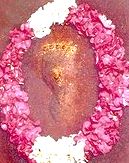
In 1970, the rock on which Swami Vivekananda spent 3 days and 3 nights meditating became the site of the Vivekananda Rock Memorial. Right opposite the memorial is a small temple built over what are believed o be the footprints of Devi Kanyakumari.
Worship And Popular Temple Festivals of Kumari Amman Temple
The rituals and worship at the Kanyakumari Bhagavathi Amman temple are performed according to the tenets that were established by Adi Shankaracharya. The priests who officiate at the temple are Brahmins from Kerala. The main festivals celebrated at the temple are :
- Chitra Poornima Festival
- Navarathri
- Vaisakha festival
- Kalabham festival
Important Information About Kumari Amman Temple
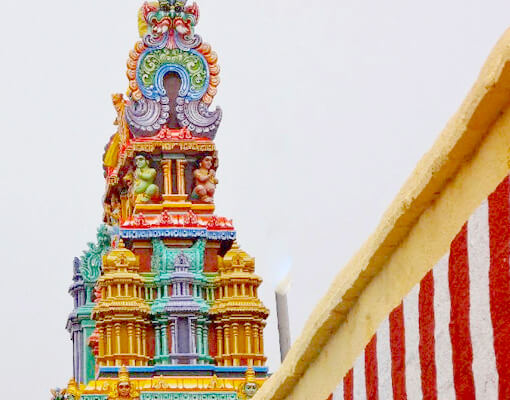
Here is some practical and useful information that will come in handy if you are planning to visit the Kanyakumari Bhagavathi Amman Temple. It is important to note that photography of any sort is prohibited inside the temple. Cameras and mobile phones cannot be carried into the temple.
Kanyakumari Bhagavathi Amman Temple Timings | Kanyakumari Temple Timings
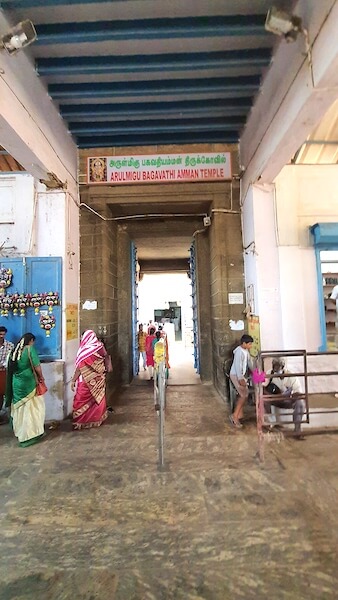
Kumari Amman Temple Kanyakumari Timings are as under:
Morning – 4:30 AM to 12:30 Afternoon
Evening – 4:00 PM to 8:15 PM
Kanyakumari Temple Dress Code
The prescribed dress code in the Kanyakumari Bhagavathi Amman Temple is, that women need to wear Sari, Salwar Kameez, or other Indian dresses. Men need to enter the temple bare-chested.
Kanyakumari Weather | Best Time To Visit Kanyakumari
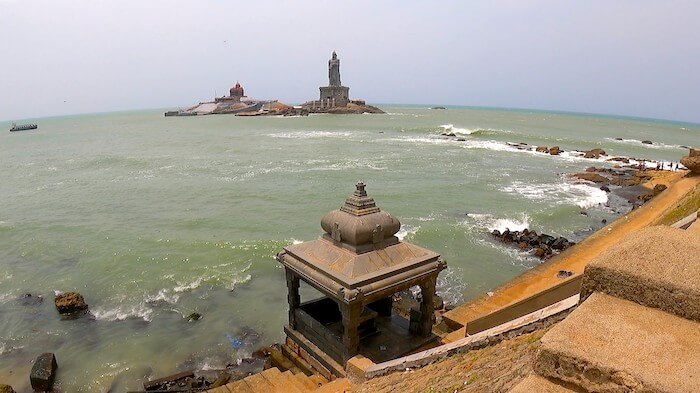
The weather in the winter months is pleasant in Kanyakumari as opposed to the summer and monsoon when humidity is high. The best time to visit Kanyakumari is between the months of October and March.
Kumari Amman Temple Kanyakumari Entry Fee
There is no entry fee for visiting the Devi Kanyakumari temple.
Kumari Amman Temple Kanyakumari Phone
The contact phone number of Shaktipeeth Shri Kanya Kumari Bhagavathy Amman Temple is 04652246223.
Images Of Bhagwati Amman Temple Kanyakumari |Kanyakumari Images | Kanyakumari Photos
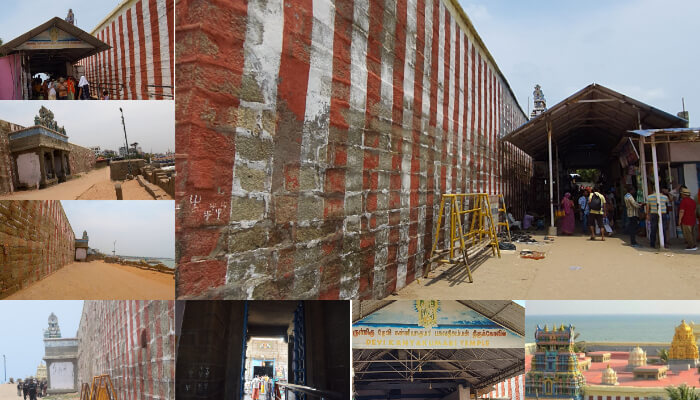
Here are some Kanyakumari images and Kanyakumari Devi Temple Photos that are sure to grab your attention and lead you to Kanyakumari.
How To Reach Devi Kanyakumari Temple

- The Bhagavathi Amman temple is located in Kanyakumari in the southern Indian state of Tami Nadu
- Kanyakumari is at a distance of about 106 kilometres from Thiruvananthapuram
- Kanyakumari is about 298 kilometres from Kochi
- Madurai To Kanyakumari distance is about 245 kilometres
By Air
The nearest airport to Kanyakumari is at Thiruvananthapuram at a distance of about 100 kilometres. The Trivandrum International Airport is well connected with major Indian and International destinations. There is connectivity with places like like Dubai, Sharjah, Bahrain, Singapore, Delhi, Bangalore, Hyderabad, and Mumbai.
By Rail
Kanyakumari is served by the Kanniyakumari Railway Station.
The station is about a kilometre from the Sarvani Shaktipeeth Shri Kanya Kumari Bhagavathy Amman Temple. The railway terminus of Kanniyakumari happens to be the starting and ending point of two of India’s longest travelling trains, the Dibrugarh-Kanyakumari Vivek Express, and the Himsagar Express.
There are trains to Mumbai, Chennai, Bangalore, Delhi, Rameshwaram, and other places from here.
By Road
Kanyakumari is well connected by road to other parts of India.
If you are planning a visit to Kanyakumari, you can book an inexpensive flight through TripAdvisor or CheapAir or Cleartrip or Makemytrip or Priceline right here. If you are thinking of travelling by road to Madurai then you can get there by self-drive car or cab or bus.
Where To Stay In Kanyakumari | Kanniyakumari Hotels
Kanya Kumari is a much sought-after pilgrimage and tourist destination. Hence it goes without saying that there are a host of accommodation options to choose from. You can book a luxury hotel, resort, or budget hotel. You can also visit Kanyakumari on a day trip from Thiruvananthapuram.
You can book Kanyakumari Hotels, Hotels in Thiruvananthapuram (Trivandrum), Hotels in Kovalam, Hotels in Kerala or any destination right here through any of the options below: TripAdvisor or Cleartrip or Makemytrip or Priceline and save a lot by getting the best deals on booking your stay.
| Click to book the best hotels in Kanyakumari or the best hotels in Kerala |
|---|
Other Places To Visit In Kanyakumari | Kanyakumari Sightseeing | Kanyakumari Tourism | Kanyakumari Tourist Places
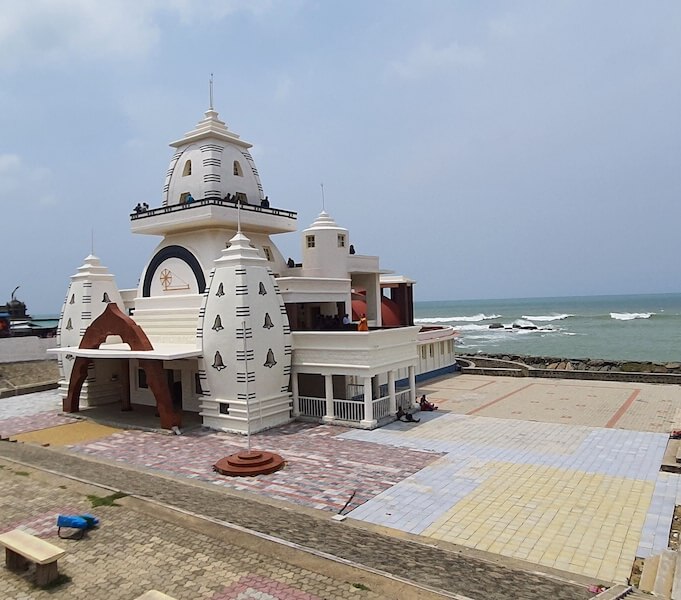
The main magnets that pull people to Kanyakumari are undoubtedly the Sarvani Shaktipeeth Shri Kanya Kumari Bhagavathy Amman Temple and the Kanyakumari Vivekananda Rock Memorial. However, there are many other places that you must include in your Kanyakumari itinerary. Here are the places you must visit in Kanyakumari:
- Kanya Kumari Bhagavathi Amman Temple
- Vivekananda Rock Memorial
- Shripada Parai
- Thiruvalluvar Statue
- Gandhi Memorial
- Vatakottai Fort
- Padmanabhapuram Palace
- Suchindram Thanumalayam Temple
- Suchindram Anjaneyar Temple
- Kanyakumari Beach
- Mathoor Hanging Bridge
- Government Museum
Kanyakumari Bhagavathi Amman Temple – FAQ
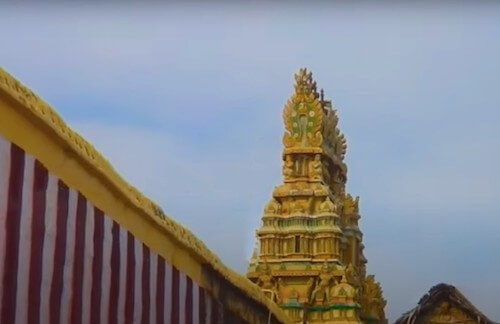
Is Kanyakumari a Shakti Peeth?
Yes, Kanyakumari is one of the 51 Shakti Peeths as the Arulmigu Bhagavathy Amman Temple is located here. It is believed that the right shoulder and part of the spine area of Sati fell at this place.
Which God is Kanyakumari?
Kanyakumari is believed to be an avatar of the Goddess Parvati. In Devi Kanya Kumari temple, she is worshipped as Katyayani, one of the Navadurgas.
Who is Bhagavathi Amman?
Bhagavathi Amman is one of the incarnations of Parvati, she is Adi Parashakti, the personification of divine cosmic energy.
Who built the Kumari Amman temple?
It is believed that the Kumari Amman temple in Kanyakumari was consecrated by Parashurama, the sixth avatar of Lord Vishnu. The foundations of the current temple were laid by the rules of the Pandya dynasty and the temple was expanded by the Nayak kings.
Why is Kanyakumari special?
Kanyakumari is special for two reasons, one is that it is a Shakti Peeth, where Goddess Bhagavathi herself is believed to have meditated. The second reason is that it is the place where Swami Vivekananda meditated, before embarking on his mission of serving the people of India.
What is the old name of Kanyakumari?
The old name of Kanyakumari was Cape Comorin.
Which temple is famous in Kanyakumari?
The Arulmigu Bhagavathi Amman Temple is the famous temple of Kanyakumari.
What should I wear to the Kanyakumari temple?
There is a dress code to be followed while visiting the Devi Kanyakumari Temple. Ladies need to wear sarees or other Indian dresses, men need to be bare-chested while visiting the temple.
Which month is best for Kanyakumari?
The best time to visit Kanyakumari is between October and March when the weather is pleasant.
Is Kanyakumari worth visiting?
One should visit Kanyakumari at least once in their lifetime.
How far is Kanyakumari from Chennai?
The distance between Kanyakumari and Chennai is about 702 kilometres.
What is Cape Comorin?
Cape Comorin is the old name of Kanyakumari.
How far is Kanyakumari from Trivandrum?
Kanyakumari is about 106 kilometres from Trivandrum.
Is there any airport in Kanyakumari?
There is no airport in Kanyakumari. The nearest airport to Kanyakumari is the Trivandrum International Airport, at a distance of about 100 kilometres.
Why you should visit Kanyakumari?
Kanyakumari must be visited for the famous Bhagvathy Amman temple, Vivekananda Rock Memorial, for its sunrise and sunset, and its natural beauty.
Does Kanyakumari have Beach?
Yes, Kanyakumari has a beach.
The feeling that you get at Kanyakumari is something special, something that is beyond the scope of words or pictures. As we left Kanyakumari behind, we carried with us two haunting images. One was the glowing face of Devi Kanyakumari and her divinely beautiful eyes, and the other image was that of Swami Vivekananda, sitting on a rock and like a rock, deep in meditation.
We hope you liked reading about the sacred temple of Kanyakumari and why it is such an important place in India. Have you been to Kanyakumari? If yes we would love to hear about your experience. If you have not been there, please do visit at least once. Subscribe to our blog for informative content about more such amazing places, also connect with us on our social media channels.
Below are some useful resources to help you book flights, hotels, and tours! And also clothes, luggage and accessories for your trip!
Flights – TripAdvisor or CheapAir or Cleartrip or Makemytrip or Priceline
Tours – Click here to book top tours around the world
Hotels – Click to book the best hotels/resorts
Choose best stay options with TripAdvisor or Cleartrip or ixigo or Makemytrip or goibibo or Hotelscombined or Priceline
Apparels – Click to buy Menswear or Womenswear or Kidswear
Accessories/Luggage – Click to buy Accessories and Luggage items
Beauty Products – Click to buy Personal Care and Beauty Products
Do You Love Traveling?
Do you want to know how to travel the world? We have put together a very useful travel resources page with the best travel tips. Go check it out now.
Thanks for visiting our site Voyager – imvoyager.com and taking the time to read this post!
If you wish to collaborate/work with us then reach us at [email protected]
We’d love it if you’d comment by sharing your thoughts on this post and share this post on social media and with your friends.
Follow our journey on our social media channels:
Facebook Twitter Instagram Pinterest YouTube
60+ Million Users Trust TripAdvisor With Their Travel Plans. Shouldn’t You?
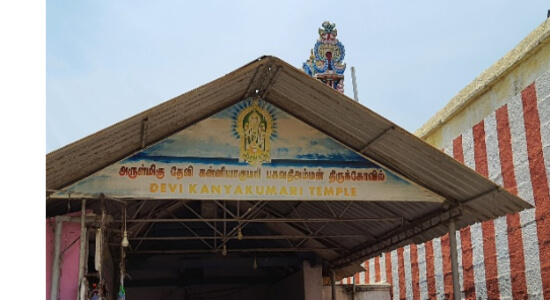
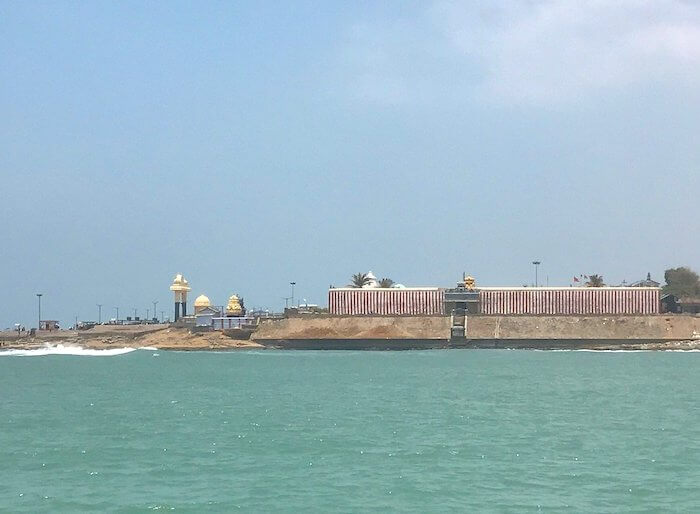
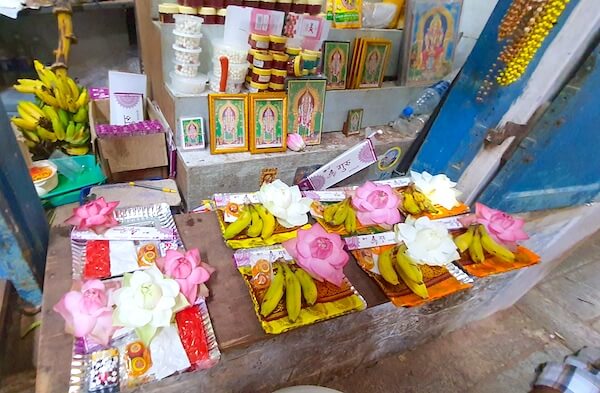
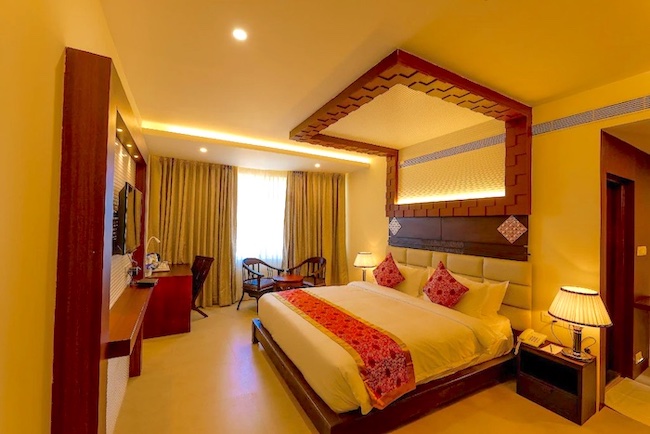

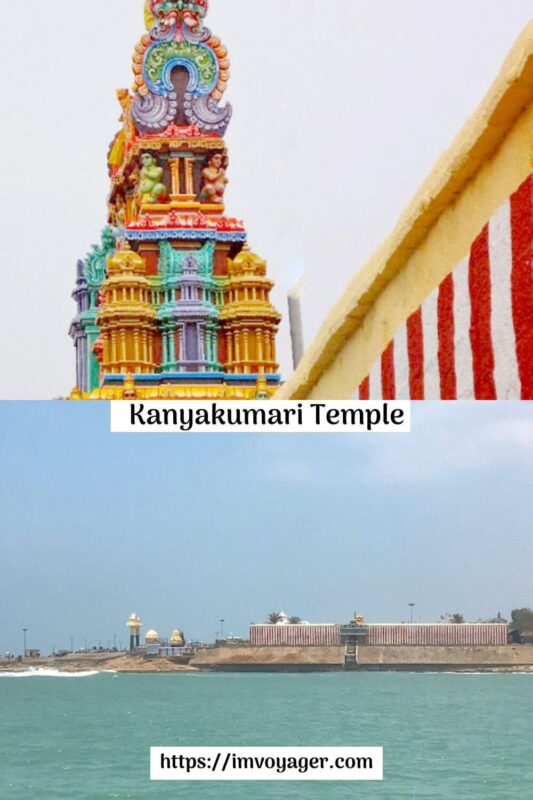

lovely post.
we missed the temple when we visited Kanyakumari. unfortunate
Got to learn so much from your blog, what A detailed Note
Our country is full of such amazing places telling us about our art, culture and the ability to build such beautiful temples, these subjects should be a part of the curriculum for the younger generation to know and learn
Interesting sharing of yours. I totally love it when I get to learn other’s culture and visiting temples is one of them. We may be divided by religion but surely with respect on each others beliefs, we can unite as one. Amazing tour!
This was a really extensive travel blog article. You have covered almost every detail that is required. Very informative and also loved to read about the temple. There is so much that our culture offers to the world. Thanks for the share.
I am amazed by reading the story and legends associated with this Kanya Kumari temple. Also the architecture of this temple is so mesmerizing. I didn’t know that Kanya Kumari is also thought to be a lost continent.
What a great learning of facts and stories in your post. Good to know about the Shakti peetha and also the nose ring story.
Looks really beautiful. Really loved the way you explained each and every detail about the temple. Hope to visit it soon 🤗